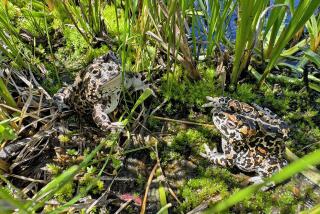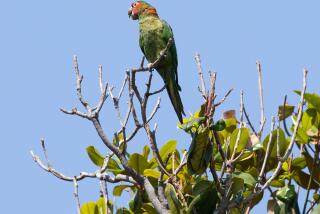The Big Apple May Become the Big Habitat
- Share via
NEW YORK — Think New York City has gotten too tame? If city officials get their way, the Big Apple will soon be crawling with peepers, screechers and even weasels.
The au natural approach to urban renewal calls for reintroducing dozens of animals and plants. The goal is to increase biodiversity and park attendance in a city that has seen plummeting crime rates and a renewal of such popular tourist spots as Times Square.
About 87 luna moths were set free in Central Park in July, dozens of bobwhite quails were let loose in September in Pelham Bay Park and eight screech owls were released in August.
Several nature enthusiasts have spotted a luna or two fluttering around at night, said Parks Department biologist Robert De Candido, who saw only bats during a recent stroll through Central Park.
“We do see a hawk every so often, though,” said Michael Bibitello, who jogs daily in the 800-acre park. His hope? That the owls do in the rats.
“The more birds the better,” concurred stroller Barbara Rhodes, who preserves books at the nearby American Museum of Natural History.
The nation’s largest city lost many of its native species decades ago for reasons ranging from predators--such as hungry squirrels and rats--to pollution.
The lucky species selected for reintroduction during the two-year project were chosen, De Candido said, with an eye toward popular appeal.
The luna, whose 5-inch wings are decorated with spots, was chosen for its exquisite pale green color and ornate tails. The 8-inch screech owl has big, round yellow eyes and makes a sharp sound when flying.
“We’re in New York, so we’re looking for catchy things,” said De Candido. “Let’s say we picked a native woodland roach--the New York Times wouldn’t run a picture of it.”
Species that have fared well include the delicate bird’s-foot violet in the Bronx borough, butterfly weed in Brooklyn’s Marine Park, the wood frog in Queens’ Cunningham Park and the Eastern box turtle on Staten Island.
But this is New York and some species aren’t tough enough. Gone are the salt-marsh bulrush at Inwood Hill Park in Manhattan and white turtlehead plants in Kissena Park in Queens.
“With the laws of Darwin, certain species might be forced out or end up on the short end of the food chain, but we’re trying,” says Parks Commissioner Henry Stern. “We want to do our best to bring more creatures to more people, and we think human contact with animals is a good thing.”
Next to be released are spring peeper toads, short-tailed weasels, gray tree frogs, water shrews and Baltimore checkerspot butterflies.
On a recent afternoon in Central Park, De Candido argued that restocking wildlife in the middle of bustling Manhattan isn’t such a strange idea.
Nearby, a troupe of actors rehearsed Shakespeare beside a restored pond, and the muffled strains of the New York Philharmonic drifted across the park.
“It’s not like this is an unusual environment,” he said. “The world becomes more like New York every day.”
More to Read
Sign up for Essential California
The most important California stories and recommendations in your inbox every morning.
You may occasionally receive promotional content from the Los Angeles Times.













